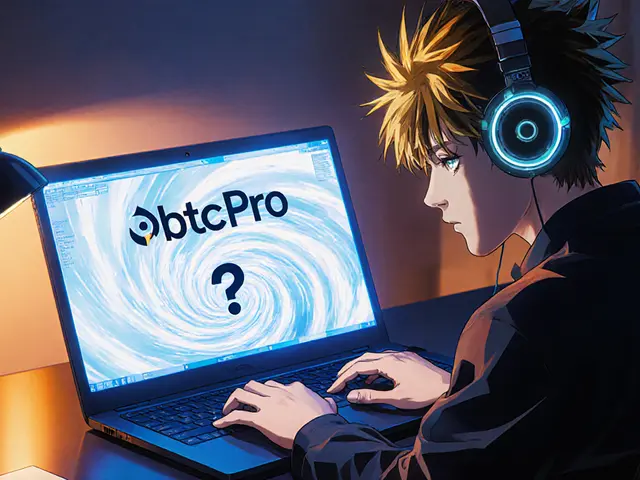Crypto Exchange Safety Checker
Use this tool to assess whether a cryptocurrency exchange meets essential safety standards. Enter the exchange name below and select the criteria that apply to evaluate its trustworthiness.
Regulatory Registration
Does the exchange have a license or registration from a recognized financial authority?
Security Certifications
Does the exchange display recognized security certifications like ISO 27001 or SOC 2?
AML/KYC Policy
Does the exchange have a clear Anti-Money Laundering and Know Your Customer policy?
Fiat Support
Does the exchange support multiple fiat currencies for deposits and withdrawals?
Customer Support
Does the exchange offer responsive and accessible customer support channels?
Transparency
Is the exchange transparent about fees, policies, and operations?
Safety Assessment Result
Quick Takeaways
- BtcPro is a little‑known platform with no public regulatory registration.
- It lacks widely recognized security certifications such as ISO27001 or AML declarations.
- Compared with Binance.US, Crypto.com, Bitkub and BitoPro, BtcPro offers fewer fiat options and higher withdrawal fees.
- Red‑flag signs include vague contact info, missing company address, and mixed user reviews.
- For most traders, sticking with a regulated exchange is the safest bet.
What is BtcPro?
BtcPro is a cryptocurrency exchange that claims to let users buy, sell and trade digital assets such as Bitcoin and Ethereum. The site’s tagline markets itself as a "fast, secure, and low‑fee" platform, but official documentation is sparse. No clear corporate registration, no ISO‑27001 badge, and no public AML (Anti‑Money‑Laundering) statement have been found on its homepage or in trusted registries.
Because the exchange is new and operates mostly in English, it attracts users looking for a low‑cost alternative to big names. The problem is that the lack of verifiable data makes any due‑diligence effort a guessing game.
How to Verify a Crypto Exchange
Before you click "Deposit," run through this checklist:
- Check the company’s registration number on the financial regulator’s website (e.g., FINCEN, FCA, MAS).
- Look for recognized security certifications - ISO27001, SOC2, or a certified custodial partner.
- Confirm that the exchange has a clear AML/KYC policy and has filed the required declarations.
- Search for independent reviews on forums like Reddit, Trustpilot, and crypto‑specific sites.
- Test customer support with a live chat or email query; note response time and professionalism.
If any of these steps raise doubts, treat the platform as high risk.
BtcPro’s Reported Features and Red Flags
The website advertises typical features: instant BTC/ETH deposits, 0.2% trading fee, and a mobile app for iOS/Android. However, several red flags stand out:
- No clear corporate address: The “Contact Us” page only lists a generic email address.
- Missing security badges: Unlike BitoPro (ISO27001 certified) or Crypto.com (FINCEN‑registered), BtcPro shows no third‑party audit.
- Withdrawal limits: Users report that after depositing >$5,000, withdrawals are frozen pending “manual verification,” a tactic common in fraud schemes such as TBAAPro.com.
- Limited fiat support: Only USD wire transfers are mentioned, whereas competitors accept dozens of fiat currencies.
These issues suggest the platform may be operating without proper regulatory oversight.

Comparison with Established Exchanges
| Feature | BtcPro | Binance.US | Crypto.com | Bitkub | BitoPro |
|---|---|---|---|---|---|
| Regulatory registration | Unclear / no public record | FinCEN‑registered, state‑licensed | FINCEN‑registered, GDPR‑compliant | SEC‑registered in Thailand | ISO27001, Taiwan AML declaration |
| Security certifications | None displayed | SOC2, 2‑FA | ISO27001, 2‑FA | ISO27001, cold‑storage custody | ISO27001, insurance fund |
| Supported fiat | USD wire only | USD, EUR, GBP (ACH, wire) | 20+ fiat, credit/debit cards | THB, USD, EUR | TWD, USD, bank transfers |
| Trading fee (spot) | 0.2% | 0% (maker) - 0.1% (taker) | 0% (LevelUp) - 0.4% (standard) | 0.25% - 0.5% | 0.1% - 0.3% |
| Withdrawal fee | Varies, often $25‑$30 | Free ACH, $5‑$10 wire | Free to Visa card, $3‑$5 bank | Free THB, $5‑$7 other | Free TWD, $3‑$5 other |
| Customer support | Email only, 48‑hour response | 24/7 live chat, phone | 24/7 chat, email | Business hours chat | Business hours chat, phone |
When you line up the numbers, BtcPro falls short on almost every front. The lack of verifiable regulation and security certifications is the biggest deal‑breaker.
Security and Compliance Checklist
Here’s what a trustworthy exchange should tick off:
- Regulatory registration: Look for a license number on the official regulator’s portal.
- ISO27001 or SOC2: Demonstrates a formal information‑security management system.
- AML/KYC policy: Must include a clear identity‑verification flow.
- Insurance or custodial partner: Platforms such as BitGo or Coinbase Custody hold user funds in cold storage.
- Two‑factor authentication (2FA): Mandatory for withdrawals.
BtcPro does not publicly list any of these items, which signals a high risk profile.
User Experience and Fees
The UI looks modern, but the onboarding process requires a KYC upload that never gets confirmed for many users. The fee schedule is vague: the terms page mentions “standard market rates” but does not break down maker/taker tiers. In contrast, Binance.US publishes a transparent fee chart that adjusts based on volume, helping traders estimate costs.
Even the mobile app, while functional, lacks push‑notifications for large withdrawals - a feature that many seasoned traders rely on for security.
Red Flags and Warning Signs
Scams often mimic legitimate names. The case of TBAAPro.com showed how a bogus platform stole $100k+ by promising “IRS verification.” Similar tactics appear in the BtcPro community: users report being asked to pay a “processing fee” before a withdrawal clears. If an exchange asks for extra payments after you have already deposited funds, walk away.
Another hint is the absence of a physical office. Reputable exchanges list a head‑quarter address, even if it’s a virtual office, and provide a phone number. BtcPro’s contact page only offers a support ticket form.
Final Verdict - Should You Use BtcPro?
For most traders, the answer is no. The exchange lacks the regulatory backbone, security certifications, and transparent fee structure that protect user assets. If you value low fees above everything else, you might still consider a test deposit of a minimal amount, but be prepared for possible withdrawal hurdles.
Safer alternatives like Binance.US, Crypto.com, or region‑specific platforms such as Bitkub and BitoPro offer proven security, clear compliance, and responsive support.

Frequently Asked Questions
Is BtcPro a regulated exchange?
No public record shows BtcPro holding a license from any financial regulator. The lack of registration is a major red flag.
What security measures does BtcPro claim to have?
The website mentions two‑factor authentication, but there is no evidence of ISO27001, SOC2, or third‑party audits. Users have reported withdrawal freezes after KYC.
Can I trade fiat‑to‑crypto on BtcPro?
Only USD wire transfers are listed, and the process is slower than the instant fiat gateways offered by Crypto.com or Binance.US.
What should I do if my withdrawal is blocked?
First, contact support and document the conversation. If they ask for extra fees, stop the process and consider filing a complaint with your local consumer protection agency.
Are there safer alternatives for beginners?
Yes. Platforms like Binance.US, Crypto.com, Bitkub and BitoPro have clear licensing, insurance funds, and robust user support, making them much safer for newcomers.









Comments (17)
Sophie Sturdevant
June 17, 2025 AT 12:28 PMAlright, if you’re eye‑balling BtcPro you need to start with the AML/KYC compliance matrix – no licence, no safety net. Check the regulator’s whitelist; a FinCEN‑registered entity will pop up in the public database instantly. Without a verified ISO‑27001 or SOC‑2 audit you’re basically betting on an unvetted cold‑storage provider. Also, scrutinize the withdrawal flow – the “manual verification” gate is a classic red‑flag for liquidity‑risk attacks. Bottom line: stack the due‑diligence checklist before you allocate any capital.
Nathan Blades
June 18, 2025 AT 05:08 AMWhat you’re describing is the very essence of asymmetric risk – you trade low fees for a potential cataclysmic loss, and that’s a decision you need to own. Think of it like walking a tightrope without a safety net; the thrill is there, but the fall is unforgiving. The market’s epistemic uncertainty amplifies when an exchange hides its licensing data. If you can tolerate that volatility in your risk‑appetite, you might still experiment with a dust‑bin amount. Otherwise, the prudent path is to stick with a regulator‑backed platform.
Somesh Nikam
June 18, 2025 AT 21:48 PMI hear you, Sophie. The lack of a public address and the vague support channel really hurts the trust equation. It’s a good practice to start with a micro‑deposit, maybe $10, and see how the withdrawal process behaves. If the “processing fee” pops up, that’s a definite stop‑sign 🚩. Stay safe and keep the community informed.
Jan B.
June 19, 2025 AT 14:28 PMFrom a plain‑language view, BtcPro’s fee schedule looks opaque and the fiat on‑ramp is basically limited to USD wires, which puts it behind most competitors.
MARLIN RIVERA
June 20, 2025 AT 07:08 AMThe whole BtcPro façade is a textbook case of regulatory evasion; without licensing it’s operating in a legal gray zone that most savvy traders avoid.
Debby Haime
June 20, 2025 AT 23:48 PMEveryone, remember that low fees aren’t worth the headache of frozen withdrawals. A solid exchange will be transparent about fees and have a responsive support team that actually answers within hours.
Richard Herman
June 21, 2025 AT 16:28 PMWhile it’s tempting to chase the cheapest platform, the broader crypto ecosystem values security and compliance over marginal cost savings.
Parker Dixon
June 22, 2025 AT 09:08 AMExactly! 🌐 A platform that skips ISO certifications is like a car without brakes – looks slick but you’re asking for trouble. 🤷♂️
Stefano Benny
June 23, 2025 AT 01:48 AMHonestly, the hype around BtcPro is overblown; most users are better off allocating capital to established exchanges with proven liquidity pools.
Bobby Ferew
June 23, 2025 AT 18:28 PMFrom a systemic risk standpoint, every undocumented exchange adds to the fragility of the market, eroding investor confidence across the board.
celester Johnson
June 24, 2025 AT 11:08 AMThe moral calculus here is clear: platforms that hide their regulatory status are effectively gambling with user assets, an unethical business model that should be condemned.
Prince Chaudhary
June 25, 2025 AT 03:48 AMRespectfully, before you write off BtcPro completely, consider that it might be a nascent venture still securing licences, though the lack of transparency is still concerning.
John Kinh
June 25, 2025 AT 20:28 PMShort‑term testing is fine, but don’t expect long‑term reliability.
Mark Camden
June 26, 2025 AT 13:08 PMRegulatory registration is not a mere bureaucratic checkbox; it anchors an exchange within a legal framework that offers recourse to users in the event of insolvency or misconduct. First, a licensed entity must submit periodic financial statements to the supervising authority, which creates an audit trail that external analysts can verify. Second, compliance with standards such as ISO‑27001 or SOC‑2 demonstrates a systematic approach to information security, encompassing encryption, access controls, and incident response procedures. Third, a robust AML/KYC program, when publicly documented, deters illicit activity and aligns the platform with anti‑money‑laundering directives enforced globally. Fourth, transparent fee structures, broken down into maker and taker tiers, allow traders to model expected costs and avoid hidden surcharges that can erode profit margins. Fifth, multi‑currency fiat support expands market accessibility, reducing friction for users who prefer to deposit in their local currency rather than convert on a secondary platform. Sixth, a responsive customer support infrastructure-ideally offering 24/7 live chat, email, and phone-provides a safety net when issues arise, such as withdrawal delays or account verification problems. Seventh, the presence of an insurance fund or custodial partnership with reputable third‑party providers offers an additional layer of protection for user assets against hacking or operational failure. Eighth, public disclosure of governance structures, including board members and executive leadership, contributes to corporate accountability. Ninth, regular third‑party security audits, with reports made available to the public, build trust by confirming that the exchange’s defenses are up‑to‑date. Tenth, clear data‑privacy policy that complies with regulations like GDPR ensures that user personal information is handled responsibly. Eleventh, the existence of a transparent dispute resolution process, possibly mediated by an independent arbiter, mitigates conflicts without resorting to litigation. Twelfth, integration with hardware wallet solutions reduces exposure to hot‑wallet vulnerabilities. Thirteenth, active community engagement, such as transparent updates on development roadmaps, signals a commitment to long‑term viability. Fourteenth, adherence to best‑practice coding standards and regular penetration testing reduces the attack surface for malicious actors. Finally, when an exchange checks all these boxes, the cumulative effect is a significantly lower risk profile, justifying user confidence and potentially attracting institutional participation.
Evie View
June 27, 2025 AT 05:48 AMYour exhaustive checklist reads like a lecture, but the reality is many traders can’t afford that level of scrutiny and still end up losing money on “perfect” platforms.
Sidharth Praveen
June 27, 2025 AT 22:28 PMStay optimistic, folks! Even if BtcPro falls short today, the market evolves and new, better‑regulated options will emerge for those willing to explore responsibly.
emmanuel omari
June 28, 2025 AT 15:08 PMOptimism is fine, but we must prioritize national financial sovereignty; relying on foreign exchanges undermines local regulatory authority and can expose users to external geopolitical risks.